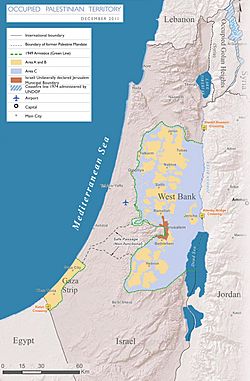Two-state solution facts for kids

The two-state solution to the Israeli–Palestinian conflict proposes to resolve the conflict by establishing two nation states in former Mandatory Palestine. The implementation of a two-state solution would involve the establishment of an independent State of Palestine alongside the State of Israel.
The first proposal for a separate Jewish and Arab states in the territory was made by the British Peel Commission report in 1937. In 1947, the United Nations General Assembly adopted a partition plan for Palestine, leading to the 1948 Palestine war. As a result, Israel was established on the area the UN had proposed for the Jewish state, as well as almost 60% of the area proposed for the Arab state. Israel took control of West Jerusalem, which was meant to be part of an international zone. Transjordan took control of East Jerusalem and what became known as the West Bank, annexing it the following year. The territory which became the Gaza Strip was occupied by Egypt but never annexed. In the aftermath of the 1967 Six-Day War, both the West Bank (including East Jerusalem) and Gaza Strip were militarily occupied by Israel, becoming known as the Palestinian territories.
The leadership of the Palestine Liberation Organization has accepted in principle the concept of a two-state solution since the 1982 Arab Summit in Fez, having previously turned down such proposals since 1937. In 2017, Hamas announced their revised charter, which claims to accept the idea of a Palestinian state within the 1967 borders, but without recognising the statehood of Israel. Diplomatic efforts have centred around realizing a two-state solution, starting from the failed 2000 Camp David Summit and the Clinton Parameters, followed by the Taba Summit in 2001. The failure of the Camp David summit to reach an agreed two-state solution formed the backdrop to the commencement of the Second Intifada, the violent consequences of which led to a hardening of attitudes among the Israeli public towards a Palestinian state and marked a turning point among both peoples’ attitudes. A two-state solution also formed the basis of the Arab Peace Initiative, the 2006–2008 peace offer, and the 2013–14 peace talks. Despite the failure of these, international consensus has for decades supported a two-state solution to the conflict.
The major points of contention include the specific boundaries of the two states (though most proposals are based on the 1967 lines), the status of Jerusalem, the Israeli settlements and the right of return of Palestinian refugees. Observers have described the current situation in the whole territory, with the Israeli occupation of the West Bank and blockade of the Gaza Strip, as one of de facto Israeli sovereignty. The two-state solution is an alternative to the one-state solution and what observers consider a de facto one-state reality.
See also
 In Spanish: Solución de dos Estados para niños
In Spanish: Solución de dos Estados para niños
- List of Middle East peace proposals
- One-state solution
- Palestinianism
- Greater Palestine
- State of Judea
- United Nations Partition Plan for Palestine
- Zionism



